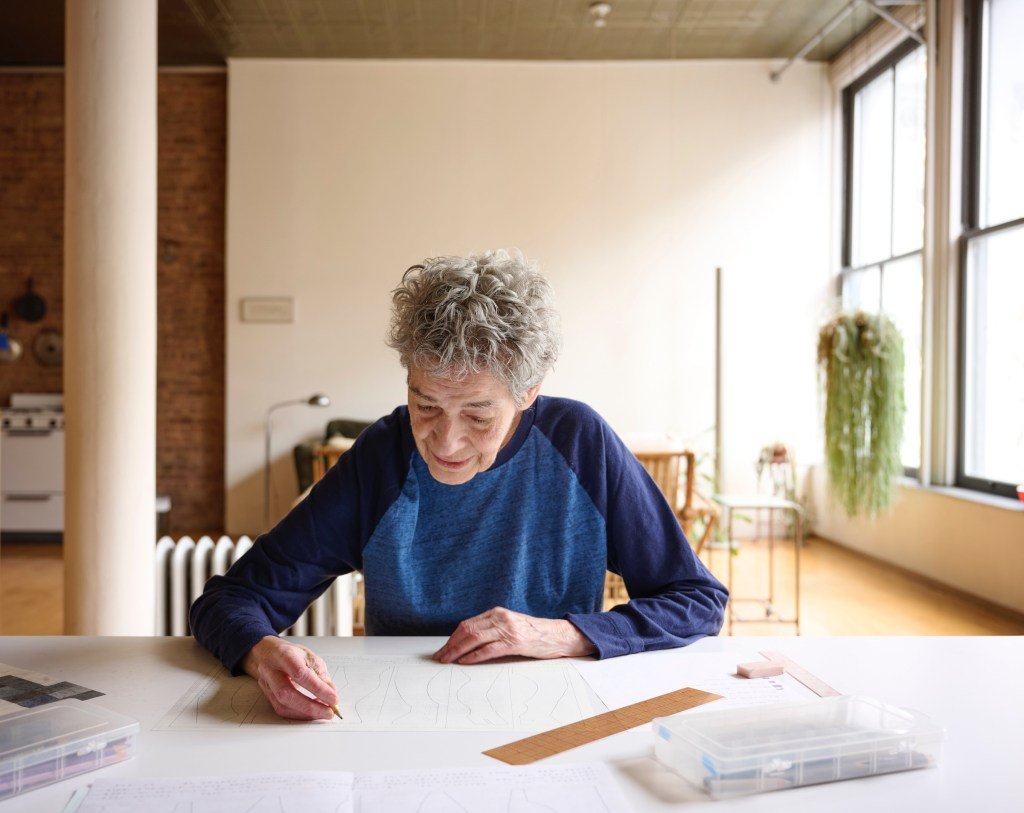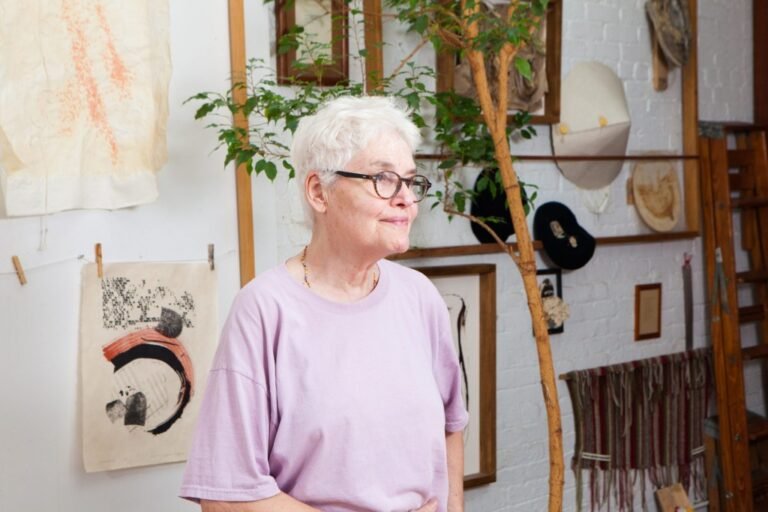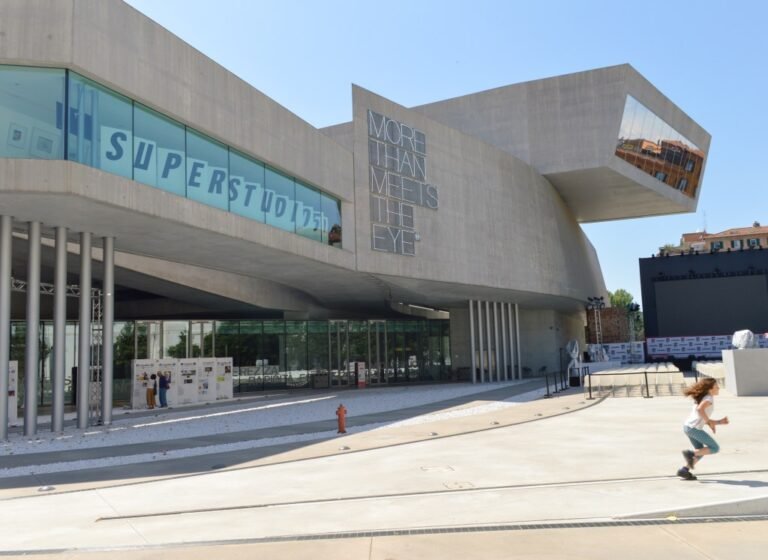

The artist Jackie Ferrara, who died last week in Basel, Switzerland, at the age of 95, liked to describe herself as a methodical drone. A sculptor of graceful wooden structures and architectural environments, Ferrara didn’t mess around with materials or half-baked ideas. She only ever began building her geometric pyramids, platforms, and tapered towers after she had meticulously plotted out every angle, line, corner, and curve. Her work was born on graph paper. She loved numbers, lists, and the stark economy of Morse code.
Ferrara planned her death with the same dispassionate logic.
The artist was neither terminally ill nor in unbearable pain when she booked a one-way trip to Pegasos, a Swiss nonprofit specializing in physician-assisted deaths. It was the prospect of losing her independence she found intolerable. Ferrara was frail and, in her final months, rarely left the spare, spacious loft in downtown New York where she’d lived alone since 1971. She moved stiffly with a walker and, when she fell earlier this year, she was too weak to stand. The month Ferrara spent recovering in a rehab facility gave her a glimpse of what the future held in store.
“It’s not good,” she told me when we met this summer, blinking hard and pursing her lips. “I mean, do you want to end up in bed with a bedpan?” she asked. “I gotta get outta here before that happens.”

Ferrara kept a folder on her computer desktop labeled “death.” Inside, there was nothing but a link to the Pegasos website. Before she fell, she would occasionally click on the link, then close the window. One day after the stint in rehab, Ferrara thought “fuck it,” and began bushwhacking through the paperwork. No, she didn’t have any pets. No, she wouldn’t like any music. Yes, she was sure.
The artist chose Switzerland because it’s one of the only places in the world where people who aren’t gravely ill can arrange physician-assisted deaths. “If I could go to Second Avenue and Houston or something, I would,” she said. Ferrara would have done it sooner if she could. October 22, 2025, was the first available appointment. Some people with limited time think about bucket lists; Ferrara thought about toilet paper. “How do I figure out how much I might need in the next three months at most?” she wondered aloud.
Born in Detroit in 1929, Ferrara achieved a rare level of renown for a woman artist of her generation. Entirely self-taught, she arrived at her mature work — geometric structures she built by stacking strips of plywood and planks of poplar, pine, basswood, and birch — in the early 1970s. Over the next several decades, dozens of major museums acquired her work, and she completed monumental commissions across the country: an amphitheater for the Los Angeles County Museum of Art, a tiled floor for the Pittsburgh International Airport, and mosaics for the Grand Central subway station, to name only a few.

But the way Ferrara told it, her career was a gigantic fluke. A prominent figure on the downtown scene in an overwhelmingly male art world, Ferrara tended to dismiss her achievements as chance accidents or state them so matter-of-factly they seemed banal. She only began making sculptures, she claimed, because Mary Frank (wife of the photographer Robert Frank) gave her some wax to play with one summer in Provincetown, Massachusetts. How her early, figurative works became the cerebral, mathematical structures for which she’s known didn’t inspire much reflection from Ferrara. One early seven-foot sculpture was “just a pyramid,” and when it appeared in a summer group show at the A.M. Sachs Gallery, the press it received was happenstance. “There’s not much happening during the summer,” she told an interviewer in 2012. Even her revels with giants of contemporary art history — poker games with Sol LeWitt, shuffleboard with Carl Andre, late nights that bled into early mornings with Robert Smithson — were always someone else’s idea. “I never initiated it,” she said. “I just happened to be somewhere with somebody and tagged along.”
Ferrara’s self-deprecation went beyond modesty or coy understatement. Her insistence on being a passenger in her own life was maddening. It also wasn’t true. Despite everything she said, Ferrara had a firm hold on her destiny.

Raised in Detroit during the Great Depression, Ferrara dreamed of moving to New York from a young age. It seemed like she might not make it there when she married the first guy who asked and dropped out of Michigan State University after one desultory year. She was pregnant almost immediately. “I was incredibly ignorant,” she said. “I would have had an abortion, but I didn’t know such a thing existed.” Her son, Brit, was born in 1951. Ferrara was miserable. Late one night, she brought her baby to “some place that boarded children,” left her husband a note letting him know where he could find their child, and boarded a red-eye flight to New York.
This was not a sacrifice Ferrara made to pursue her art. She had no real ambitions at the time. When she landed in New York, she figured she’d be a go-go dancer. Perhaps it’s not surprising that when Ferrara did become an artist years later, she built ramparts — literal towers and walls — to shield this reckless woman from view. Insisting on her own lack of imagination (she often said she possessed “the soul of a file clerk”), Ferrara contained the destructive mayhem of her life behind aloof, systematic sculptures.
“I came here actually thinking at some point that I would go back and get Brit and live with him here,” she said. “But,” she added in a whisper, “I didn’t.” Once it came up, Ferrara often spoke about leaving her son. She was talking about the artists Mel Bochner and Dorothea Rockburne one day when she suddenly broke off. “All these people who love their children, and here’s me who abandoned mine,” she said. Some of these interjections were so random, it seemed like Ferrara was still wrapping her head around being the kind of person who chooses personal happiness over her child. If Ferrara was ashamed of her decision, though, she didn’t seem to regret it.

Sometime in the early 1990s, Ferrara made a sculpture called “Arena 7.” Blond plywood walls frame a central, rectangular space with a doorway at either end. Ferrara said she’d been thinking about Frank R. Stockton’s short story “The Lady, or the Tiger?” (1882), in which a young man trapped in the arena of a barbaric king must choose between two doors. Behind one lies happiness in the form of a beautiful maiden; behind the other, certain death by savage tiger. The man’s lover, the princess, gestures to the right, but the story ends before we learn whether she was saving him or sending him to his death. When Ferrara was in junior high, she wrote a different ending. In her version, the young man knows the princess “wasn’t to be trusted,” and escapes through the opposite door. In many ways, Ferrara was that ruthless princess, but she was also the young man — the one who, in her telling, escaped his doom by taking a colossal risk.
The last time I saw Ferrara was in August. She was giddy. Her trip to Switzerland was only two months away. “I’m looking forward to it,” she said. “I’m going to be their jolliest customer.” Sunlight flooded the corner where Ferrara sat behind a pale wooden desk beside her neatly made bed. She wore a loose red T-shirt under navy blue overalls, red slippers, and her silver hair in a mop of curls. Blue and purple veins shone through her skin. It was weird, she said, knowing she wouldn’t be around for New York City’s mayoral election or live to see the garden her neighbors were planning on the roof she’d looked down on for 54 years. Not weird enough, though, to make her question her decision. “None of this makes me feel bad, truly,” she said, holding my gaze with her large dark eyes.
Near us, a dozen of Ferrara’s small wooden sculptures sat on tables and shelves. In static photos, they can seem rigid and impersonal, but that afternoon, in the golden summer light, they looked almost alive. The radiant slats of rosy wood and bands of shadow between them seemed to flicker and strobe. Walking around them, they appeared to rotate, warp, tilt, and skew. The artist Laurie Anderson put it succinctly in a 1974 review for Artforum: “They are more about verbs than nouns.” Although Ferrara’s sculptures emerged from clinical diagrams on paper, their physical presence in the world is unruly. Ferrara might have sought to contain the chaos of her life in precise, geometric forms, but their subtle unpredictability reflects her own.


